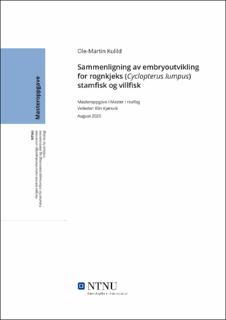| dc.contributor.advisor | Kjørsvik, Elin | |
| dc.contributor.advisor | Hansen, Bjørn Henrik | |
| dc.contributor.author | Kulild, Ole-Martin | |
| dc.date.accessioned | 2021-09-25T16:01:25Z | |
| dc.date.available | 2021-09-25T16:01:25Z | |
| dc.date.issued | 2020 | |
| dc.identifier | no.ntnu:inspera:56277320:16059713 | |
| dc.identifier.uri | https://hdl.handle.net/11250/2782464 | |
| dc.description.abstract | Med ambisjon om å femdoble norsk lakseproduksjon, står fiskenæringen og staten foran utfordringer knyttet til høyt smittepress av lakselus. Per i dag er utsetting av rensefisk i merder den mest brukte metoden for bekjempelse av lakselus i Norge. For å møte næringens etterspørsel av den populære rensefisken rognkjeks (Cyclopterus lumpus) på et bærekraftig vis er det nødvendig å øke produksjonen og begrense bruk av villfanget fisk. I kultivering av rognkjeks utgjør ustabil eggproduksjon en foreløpig flaskehals, og følgelig er det behov for økt kunnskap om rognkjeksens embryoutvikling.
I studien er rognkjeksens embryoutvikling undersøkt for påvirkningen av lipidandel i fôret hos embryoets morfisk. Som mål av embryoutvikling er det undersøkt parameterne befruktningsprosent, klekkesuksess, larvelengde, eggdiameter, hjerterate, morstørrelse, tørrvekt og respirasjon. Embryoutviklingen er sammenlignet for egg fra seks villfisker og 11 stamfisker fordelt på tre ulike dietter med variasjon i lipidandel. Det blir også gjort korrelasjonsanalyser mellom parameterne for utvikling av embryo.
I studien viser at embryoutviklingen er ulik for egg fra villfisk og stamfisk. Generelt er forskjellen større desto mindre lipid det er i morfiskens fôr. Studien antyder også at temperaturen morfisken opplever under modning av egg, påvirker størrelse og energireserver hos eggene. | |
| dc.description.abstract | With ambition to fivefold Norwegian salmon production, fishing industry and the state face challenges related to high infection pressure from salmon lice. As of 2019, the release of cleaner fish in cages is the most used method for controlling salmon lice in Norway. In order to meet the industry's demand for the popular cleaner fish lumpsucker (Cyclopterus lumpus) in a sustainable way, it is necessary to increase the production of lumpsucker and limit the use of wild-caught fish. In the cultivation of lumpsucker, unstable egg production constitutes a preliminary bottleneck, consequently there is a need for increased knowledge about the lumpsucker’s embryo development in order to improve production.
In the study, the embryo development of the lumpsucker was investigated for the influence of the lipid content in the feed of the embryo's mother fish. As a measure of embryo development, the parameters fertilization percentage, hatching success, larval length, egg diameter, heart rate, maternal size, dry weight and respiration have been investigated. Embryo development has been compared for eggs from six wild fish and 11 broodstock fish divided into three different diets with variation in lipid content. Correlation analyses have also been performed between the parameters for embryo development.
The study shows that embryo development is different for eggs from wild-caught fish and broodstock fish. In general, the difference is greater the less lipid there is in the mother's feed. The study also suggests that the temperature the mother experiences during maturation of eggs affects the size and energy reserves of the eggs. | |
| dc.language | | |
| dc.publisher | NTNU | |
| dc.title | Sammenligning av embryoutvikling for rognkjeks (Cyclopterus lumpus) stamfisk og villfisk | |
| dc.type | Master thesis | |
